Not so long ago she was one of Józef Piłsudski's closest friends. Now, involuntarily, they stood on either side of the barricade. Was it their private dispute that in May 1926 almost 400 people lost their lives, and the Polish experiment with democracy became history?
It was not easy for Stanisław Wojciechowski to assume the duties of president. His wife had even bigger problems with that. In her youth, she was a revolutionary, courier and freedom fighter. But she definitely did not have any advances for politics.
The first twelve months on the candlestick turned out to be extremely turbulent. Only the next, 1924, brought some improvement. The political situation stabilized for a while, and Wojciechowski undertook several well-rated initiatives. The calm did not last long, however.
Fight for everything
On the one hand, Poland was hit again by the economic crisis. The resourcefulness of Maria - who felt much better as a hostess than a grand lady - came in handy, because at the beginning of 1926, the president jointly and severally decided to cut the Belvedere budget by ten percent.
A more serious problem grew in relations with the former friend of the presidential couple - Józef Piłsudski.
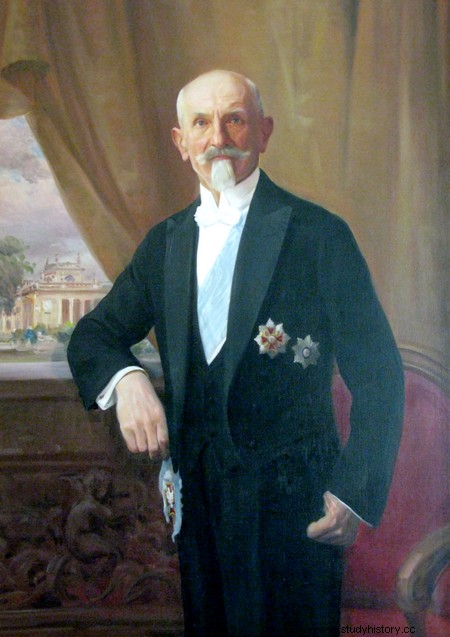
President Wojciechowski in the portrait by Kazimierz Dunin-Markiewicz (source:public domain).
Immediately after Wojciechowski was elected, it seemed that the contacts between the head of state and the former governor would be perfect. On one of the first visits after taking office, the president went to Piłsudski. Maria was with him.
The Marshal's subordinate, Adam Korwin-Sokołowski, recalled:
President Wojciechowski and his wife paid a visit to Marshal Piłsudski. (...) I reported to the President and piloted him to the first floor to the Marshal's apartments. The Marshal awaited the President in the open door of his office. The visit lasted about an hour.
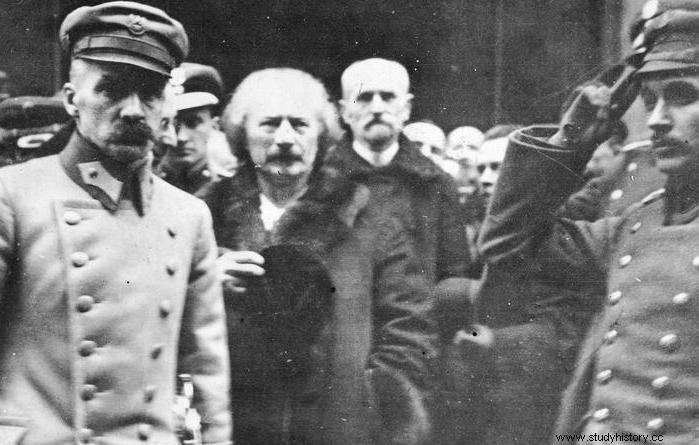
Stanisław Wojciechowski and Józef Piłsudski were longtime friends and co-workers. Everything changed after Wojciechowski became president. In the photo from February 1919, from the left, Piłsudski, Paderewski and Wojciechowski in front of St. John in Warsaw (source:public domain).
It was one of the last gestures of mutual cordiality. The contacts were getting worse month by month. The marshal demanded more influence on politics, the president defended his independence.
Bits of friendship
Only memories remain of the old friendship. It must have been a heavy blow to Maria. She and Ziuk had years of common experience between her and her. And it's not just about chops or courier missions (which I wrote about in another article) . After all, it was Józef who introduced her to Staś. And he fought with the Bolsheviks for Kupryszki - her family fortune.
"Tell your wife that I have not yet reached Giedroyc, he must wait with his vacation in Kupryszki" - you can read in a letter sent by Piłsudski to the then Minister of the Interior, Stanisław Wojciechowski, during the Polish-Bolshevik war. As you can see, for Maria Ziuk was really ready for a lot….
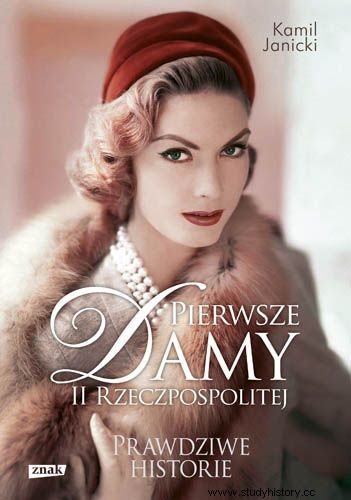
Get to know the profiles of extraordinary women who stood alongside the presidents of pre-war Poland. The article is based on the book by Kamil Janicki entitled "The First Ladies of the Second Polish Republic."
Purely Personal War
And now? Piłsudski's immediate surroundings did everything to destroy the president's reputation. Wojciechowski's adjutant, Henryk Comte, wrote with embarrassment that there were a lot of anecdotes and stories about the family life of the family and Maria herself. "Soon, as a (...) adjutant I could find out that there was a lot of deliberate malice in them, more fabrications, fantasies and mockery ”- he recalled.
In turn, a well-known social activist and a lady from the society, Janina Dunin-Wąsowiczowa, wrote in her diary that it was "the person of Mrs. Wojciechowska" that was the main subject of jokes with the president and an inspiration for more and more anecdotes.
Many of these rumors survived in the diaries and memories of representatives of the pre-war elite. I devoted a whole chapter to them in the book "First Ladies of the Second Republic of Poland" .
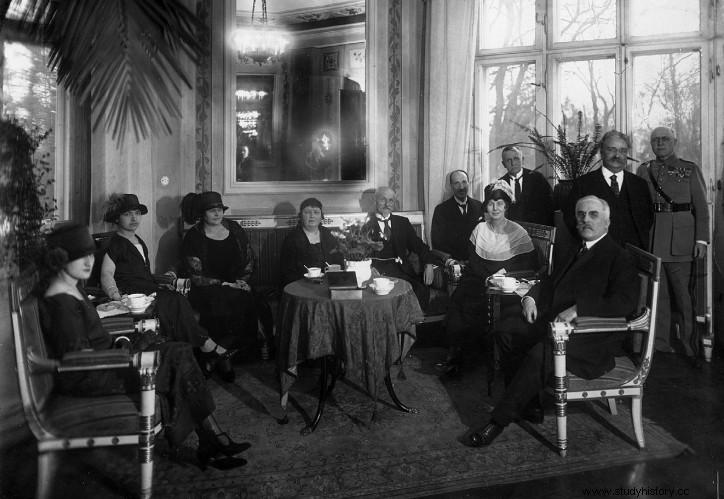
Visit of the French Minister of Labor Justin Gotard to the Belweder Palace. The fourth on the left, at the side of her husband, is Maria Wojciechowska. Photo from 1925. The photo and the caption come from the book by Kamil Janicki entitled "The First Ladies of the Second Republic of Poland".
Others are difficult to recreate today, after more than ninety years. On the other hand, the fact that the hate campaign aimed at the presidential couple was a deliberate and wide-ranging action is beyond doubt.
Industry of contempt
Józef Kuropieska - later a general and member of the Polish People's Republic parliament, but also a knight of the Order of Virtuti Militari - wrote in his memoirs:
Press bodies under the influence of Piłsudski's people were clearly campaigning against Wojciechowski.
The gossip community did not spare his wife, the supposedly "thrifty bourgeoisie", by spreading various malicious anecdotes among us, who maintained relations with Piłsudski's people.
Preventive townswoman? For Maria, being careful was a source of pride rather than shame. Another thing is that she was a noblewoman from her great-grandfather, and not a townswoman.
If they meet, it will be an agreement
The conflict escalated, and historians are still arguing about who was at fault and why the dispute over the choice of the head of government ended in a coup d'état. There is no doubt that the president underestimated the gravity of the situation to the very end. And not only him. Even those almost in the center of the events did not acknowledge the possible bloodshed.
Piłsudski's secretary, Kazimiera Iłłakowiczówna, recalled years later that everyone expected reconciliation between their old comrades:"But President Wojciechowski (...) is an old friend, and today a supporter of Piłsudski (...). Well, if something, someone has somewhere, then when these two meet - it will be agreed. "
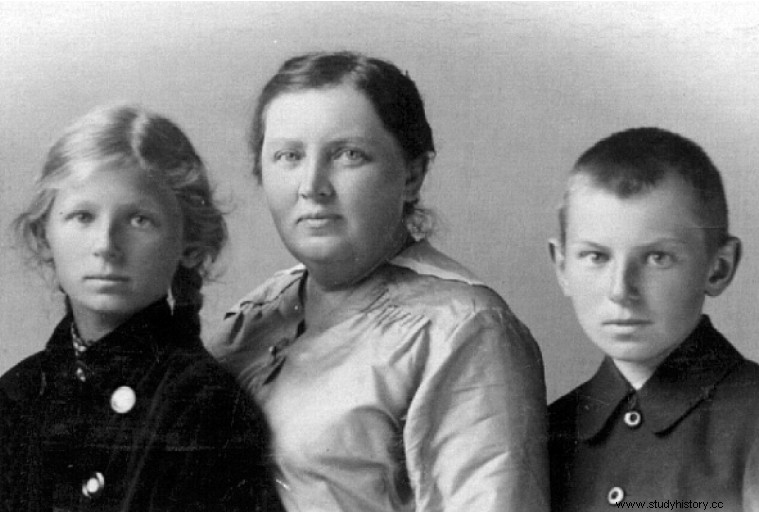
For Maria Wojciechowska, forethought was certainly something to be proud of. In the photo, Maria with her children. The photo comes from the book by Kamil Janicki entitled "The First Ladies of the Second Republic".
The price of disregard
And yet there was no consent. The president did not even try to look for her too much, because he did not believe that Józef Piłsudski would dare to openly oppose him and trample the constitution. On his part, the Marshal saw signs of contempt in Wojciechowski's disrespectful approach. He considered unintentional tactics and mistakes to be deliberate attacks.
In one such mistake, the first lady played a leading role. The second hero was Colonel Bolesław Wieniawa-Długoszowski - Piłsudski's trusted associate and right-hand man, and at the same time the first reveler of Warsaw, if not all of Poland. Henryk Comte recalled:
At the end of April 1926 (...) Colonel Wieniawa-Długoszowski reported to the president on the orders of Marshal Piłsudski. Due to a misunderstanding, which I still cannot explain to myself today, I reported it not to the president, but to president Wojciechowska.
Colonel Wieniawa was surprised to find himself unexpectedly faced by the president's wife. They both just hated each other. (…)
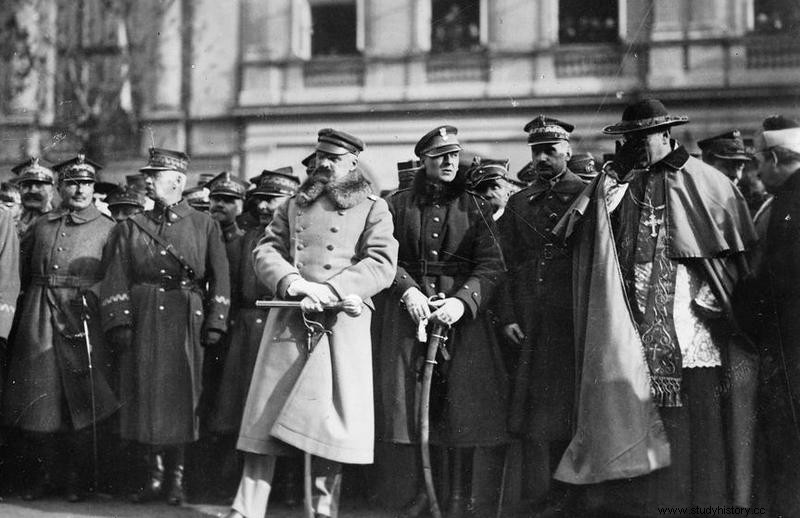
Maria Wojciechowska was definitely offended by the boisterous lifestyle of Wieniawa-Długoszowski. In the photo, Wieniawa stands to the right of Józef Piłsudski (source:public domain).
Wieniawa's conversation with the First Lady lasted less than three minutes. He came out of the office, or rather all purple fell out. What did Ms Wojciechowska say and what Ms Wojciechowska said to him - I never found out. I only noticed that the First Lady was extremely nervous about this visit and she could not forgive me for a long time.
Frivolous entertainment and serious politics
Wieniawa was known in the capital city for his all-night drinking, games in minor dives, and even for returning from a libation in three horse-drawn carriages - so that in one he rode alone, in the other his saber, and in the third gloves. According to Henryk Comte, "Ms Wojciechowska was clearly scandalized by the frivolous acts of Mr. Wieniawa [and] she often expressed her indignation".
This opinion is confirmed by the president's grandson Maciej Grabski:“I know that she hated him! Because it was a bully. He was disrespectful towards women (tolerance was quite low here) ”. No wonder then that when Maria Wojciechowska faced Wieniawa in the tense atmosphere of the spring of 1926, she won him whatever she had on her heart.
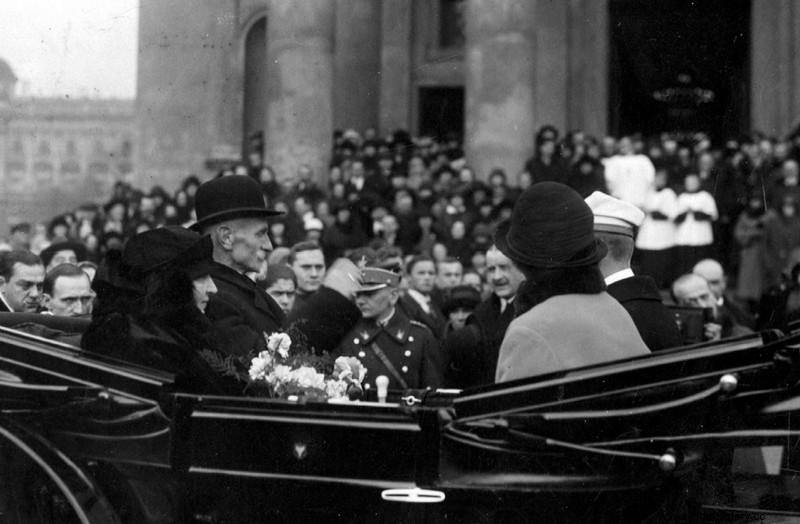
Maria probably told Wieniawa what she thought about Piłsudski's behavior towards her and her husband. The photo shows the presidential couple during the celebrations related to their silver weddings. The photo comes from the book by Kamil Janicki entitled "The First Ladies of the Second Republic".
Rather, she did not lower herself to personal attacks - that would not be her style or her level. But she certainly did not forgive herself the grudge against her faithful friend (and Wieniawa's superior) who treated her and her husband so hideously.
Affront or misunderstanding?
Comte himself admitted that the incident could have been perceived as “a deliberate affront committed by the president to Marshal Piłsudski. For although it was not him who fell out of the Belvedere as from a slingshot, but his envoy, in this envoy the second incarnation of the marshal was quite commonly seen. "
Was it Maria Wojciechowska who led to the May coup? This cannot be ruled out. A stormy conversation with Colonel Wieniawa was one of the stones that struck the avalanche. Who knows, it's not the last one.
Maybe immediately after it, or maybe a few days later, Józef Piłsudski decided that the time for negotiations was over. He decided to go back to politics by force, overthrow the government and crush the president's resistance.
Source:
The article is based on the materials collected by the author during the work on the publication "First ladies of the Second Republic of Poland" (Wydawnictwo Znak, 2012) . The family illustrations come from the collection of Maciej Grabski, made available for the book.
